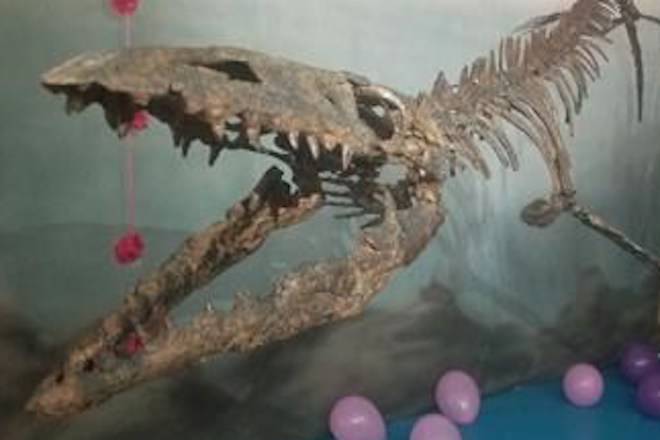Suzy, Bruce and now a new prehistoric sea-creature skeleton make three at a southwestern Manitoba museum.
The Canadian Fossil Discovery Centre in Morden unveiled its latest mosasaur skeleton on Wednesday.
The museum is already home to Bruce — the Guinness World Records holder as the largest publicly displayed mosasaur — and his museum companion Suzy.
RELATED: 50-million-year-old fossil found in B.C. town makes history
Mosasaurs were huge, strange-looking marine reptiles that lived throughout the world during the late Cretaceous period between 66 and 100 million years ago. They went extinct around the same time as the dinosaurs.
Mosasaurs were predators at the top of the food chain. They were powerful swimmers with long, broad tails. They also had a double-hinged jaw, similar to a snake, and ate everything from birds and mollusks to fish.
Discovery centre curator and paleontologist Victoria Markstrom said the new specimen is different than most of its fossil friends. It’s a Kourisodon puntledgensis mosasaur which is quite rare.
It has razor-like teeth for shearing its food rather than crocodile-style teeth for chomping like the other specimens.
RELATED: 53 million year old scorpionfly fossil found in B.C.
“Because (the teeth) are laterally compressed, because they have this shape, some scientists think that they would use it for biting down on softer animals,” Markstrom said. “These (mosasaurs) might have been eating more things like soft fish, jellyfish, squid and whatnot.”
It’s also much smaller — only 3.7 metres compared to 13-metre-long Bruce. Markstrom said that’s because the new creature was found on Vancouver Island.
Bruce and Suzy were unearthed in Manitoba. They would have roamed the Western Interior Seaway, which stretched from the Arctic Ocean to the Gulf of Mexico, cutting North America in half.
“It shows that whatever was going on in the Pacific Ocean, they had some pretty small mosasaurs living there,” said Markstrom, who added that fossils of the species have otherwise only been found in Japan.
“We don’t usually get a lot of information about the animals that lived in the ancient Pacific Ocean because they are not usually found.”
The new skeleton does not have a name yet. Markstrom said the centre will work with the public to come up with one in the coming months.
The Canadian Press



